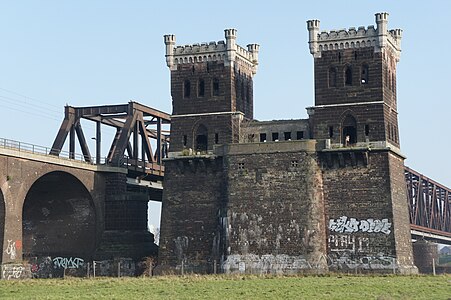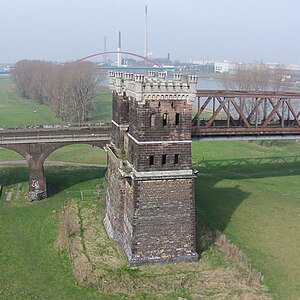Duisburg-Hochfelder railway bridge
Coordinates: 51 ° 24 ′ 28 " N , 6 ° 44 ′ 40" E
| Duisburg-Hochfelder railway bridge | ||
|---|---|---|
| use | Railway bridge | |
| Convicted | Duisburg – Mönchengladbach line | |
| Crossing of | Rhine | |
| place | Duisburg | |
| construction | Truss bridge | |
| Longest span | 189 m | |
| start of building | 1872; 1926; 1948 | |
| completion | 1873; 1927; 1949 | |
| Status | in operation | |
| location | ||
|
|
||
The Duisburg-Hochfelder railway bridge is a Rhine bridge between the Duisburg districts of Hochfeld and Rheinhausen . The first bridge train was built by the Rheinische Eisenbahn-Gesellschaft and put into operation at the end of 1873. The structure was replaced by a new bridge in 1927, which, after being destroyed in the war, still serves rail traffic between the Ruhr area and Aachen .
The Duisburg-Hochfeld Railway Bridge convicted originally Osterath-Dortmund Süd railway , together with the now Duisburg-Ruhrort-Mönchengladbach railway , the railway line Duisburg-Mönchengladbach forms.
history
prehistory
On 23 August 1866 , the Rheinische Eisenbahn-Gesellschaft opened the Osterath - Essen railway with the Rheinhausen - Hochfeld trajectory for the transport of coal from the Ruhr area via its then predominantly left-bank railway network . At that time, the Prussian military only permitted the construction of permanent Rhine bridges at garrison locations such as Düsseldorf , Cologne , Koblenz and Mainz . When there was a change of opinion around 1869, the railway company immediately applied for the bridge from Rheinhausen to Duisburg to be built . The Pfaffendorfer Bridge in Koblenz, completed in 1864, was the model for the construction .
The first bridge

The royal Prussian concession of July 29, 1871 for the construction of a railway bridge in the course of the Osterath-Essener Bahn near Rheinhausen required conditions:
- Construction of mine chambers in all bridge piers,
- Construction of defense towers ( tambour systems ) on both bridgeheads and connected swing bridges to close the bridge in the event of war.
- Removal of the trajectories on the banks
- Payment of 300 thalers to the military treasury for two gunboats .
Since the Rheinische Eisenbahn-Gesellschaft had largely prepared the construction according to plans by the railway engineer Emil Hermann Hartwich , construction of the double-track bridge at km 774.36 on the Rhine could already begin in early 1872. Despite two floods , it was completed after two years.
On the left bank of the Rhine, it was given a brick receiving water bridge with 16 openings, each with a clear width of 50 feet. This was followed by the swing bridge on a central pillar, around 34 meters long and 10 meters wide. In the event of an attack, it would have been rotated 90 ° in the middle, making it impassable for soldiers and trains. Subsequent to the drum tower, which also had two openings for the pedestrian walkways on both sides, followed the four river bridges, each with a span of 98 meters on three river pillars. They were made as two-joint truss arches from 2,800 tons of welding iron by the Jacobi, Haniel & Huyssen company in Oberhausen . A short flood bridge with six openings, each 50 feet, was connected to the bridge tower on the right bank of the Rhine behind the swing bridge. The bridge train had a total length of around 800 meters.
After the police inspected the bridge on December 23, 1873, goods traffic ran over the bridge from December 24. The passenger trains were hauled until January 14, 1874. Subsequently, the four- lane trajectory could be dismantled. The Rheinische Bahn puts the construction costs at around 2.5 million talers .
The steadily increasing rail traffic over the bridge and the increasingly heavy train weights led to the first damage to the bridge as early as 1910 and in early 1914 the first plans for a new bridge were drawn up, which, however, did not take place due to the First World War .
Bomb attack
On June 30, 1923, during the occupation of the Rhineland , while crossing the Rhine bridge near Duisburg, a Belgian military train allegedly exploded a bomb that was supposed to have been equipped with a time fuse. Eight people died, several were injured (the exact number of injured and fatalities fluctuated in the reporting, however, from eight people to twelve, who are said to have died of their injuries in the following days.) The occupiers were on the side from the beginning an assassination attempt was established as a certain cause. The German authorities and the German daily press were more cautious and suspected, among other things, a defective gas container as the cause of the explosion.
As a result of the assassination attempt and the alleged German perpetrators, the Belgian General Beaurain, who was responsible for the Duisburg bridgehead, issued several ordinances for the city of Duisburg on July 1, 1923. These included bans on passenger cars and trams , as well as a curfew at night and an ID requirement. In addition, the entire Franco-Belgian occupied area was cordoned off from the rest of the German Empire and border controls expanded.
The second bridge
Construction of the second bridge began in 1925, and it was operational on October 13, 1927. It was built just a few meters downstream (river kilometer 774.38) from the first bridge. This was completely demolished except for the bridge pillar on the left bank of the Rhine in order not to hinder shipping and the outflow of floods .
The new bridge consisted of a stepped parallel framework (Gerber beam) and left a fairway almost 180 meters wide for shipping. The main bridge, 20 meters high, had two openings with spans of 126 meters and 189 meters. It was continued on both sides with a 104-meter-wide and 10-meter-high foreland bridge and had an opening with a span of 51.8 meters on the Duisburg bank to bridge the industrial tracks there. On the left bank of the Rhine, the receiving water area was overcome with a brick bridge that has 19 openings, each with a span of 15.60 meters. A footbridge was attached to its north side. The steel superstructure of a total of 907 meters was built long and consists of approximately 7,500 tons of steel bridge train from the adjacent bridge institution of the Friedrich-Alfred-Hütte in Rheinhausen and the Duisburg bridge construction company Harkort .
This bridge, built from a steel St 48 , was hit by a bomb on May 22, 1944 at its left end, which made it impassable. The damage was largely repaired by the neighboring company Krupp within 17 days with an auxiliary bridge and an auxiliary pillar. Less than a year later, on Sunday, March 4, 1945 at 11 a.m., German troops blew up the entire bridge as they retreated from the approaching 9th US Army as part of Operation Grenade on the right bank of the Rhine. She had previously been burdened with a fully loaded coal train. The middle pillar of the river was also completely destroyed.
The third bridge
Immediately after overcoming the Rhine, American pioneers began 50 meters upstream in the axis of the old Rhine bridge from 1873 with the construction of a single-track temporary bridge 844 meters long. As early as May 8, 1945, the 332nd Engineer General Service Regiment, a pioneer unit of the US Army, inaugurated the war bridge that was built in just one week. This could already be put into operation on May 12, 1945. For the access tracks, high embankments had been poured on both sides with the abundant rubble across the Krupp and Reichsbahn marshalling yards . The bridge was named "Victory Bridge". It was closed in October 1946 due to danger from floods and ice drifts and demolished a short time later.
The fourth bridge
In August 1945, the salvage of the remains of the blasted bridge began. Parts that were still usable were secured and supported. As a result, almost half of the old construction could be reused in its original form in the new building. The fourth bridge went into operation again on October 1, 1949 and is still in operation to this day. In autumn 2001 a bridge renovation took place over several months.
In addition to freight trains, the regional trains RB 31 " Der Niederrheiner ", RB 33 " Rhein-Niers-Bahn " and RB 35 " Emscher-Niederrhein-Bahn " as well as the regional express lines RE 42 " Niers-Haard-Express " run over this bridge. and RE 44 “Fossa-Emscher-Express”.
On the downstream side there is a wide footpath that is also used by cyclists.
environment
On the east side of the Rhine bridge, downstream in the Hochfeld district, has been the Rheinpark since 2009 , an area of around 25 hectares that was originally intended to be part of an unrealized federal horticultural show in Duisburg.
Opposite on the left bank of the Rhine is the Rheinuferpark, which was laid out in the early 1950s by the formerly independent town of Rheinhausen. The old bridge pillar of the first bridge on the Rheinhauser side up the Rhine was auctioned in December 2014 by the real estate company of Deutsche Bahn AG to a currently unknown bidder for 30,000 euros.
|
The next bridge upstream: Krefeld-Uerdinger Bridge |
Bridges over the Rhine |
The next bridge downstream: Bridge of Solidarity |
literature
- Annual reports of the Rheinische Eisenbahngesellschaft
- Friedrich Albert Meyer: Rheinhausen am Niederrhein in the historical process . Rheinhausen 1956.
- The German Rhine Bridges . Stahlbau Verlag, Cologne 1956.
- Deutsche Reichsbahn: The German Railways in their Development 1835–1935 . Berlin 1935.
- Annual reports of the Rheinische Eisenbahngesellschaft
- Hartwig Unverdorben: Rhine crossings in the Duisburg area , in: Yearbook 1988/1989 of the districts of the city of Duisburg on the left bank of the Rhine (Ed .: Freundeskreis lebige Grafschaft eV Duisburg, ISSN 0931-2137 ), p. 84ff
- Willy vom Felde: Building bridges ; in: Yearbook of the districts of the city of Duisburg on the left bank of the Rhine 1988/89, p. 90 ff; (Ed. Freundeskreis lively Grafschaft, Duisburg 1989), ISSN 0931-2137
- Hans-Paul Höpfner: Railways. Your story on the Lower Rhine . Mercator Verlag, Duisburg 1986, ISBN 3-87463-132-X .
Web links
- Duisburg-Hochfelder railway bridge. In: Structurae
- Description of this sight on the route of industrial culture
- Entry on the Rheinbrücke Hochfeld in the database " KuLaDig " of the Rhineland Regional Association
- Photo of the icy Rhine in 1929 under the aforementioned Rhine bridge (digit.wdr.de)
- Aerial view of the old bridge pier






